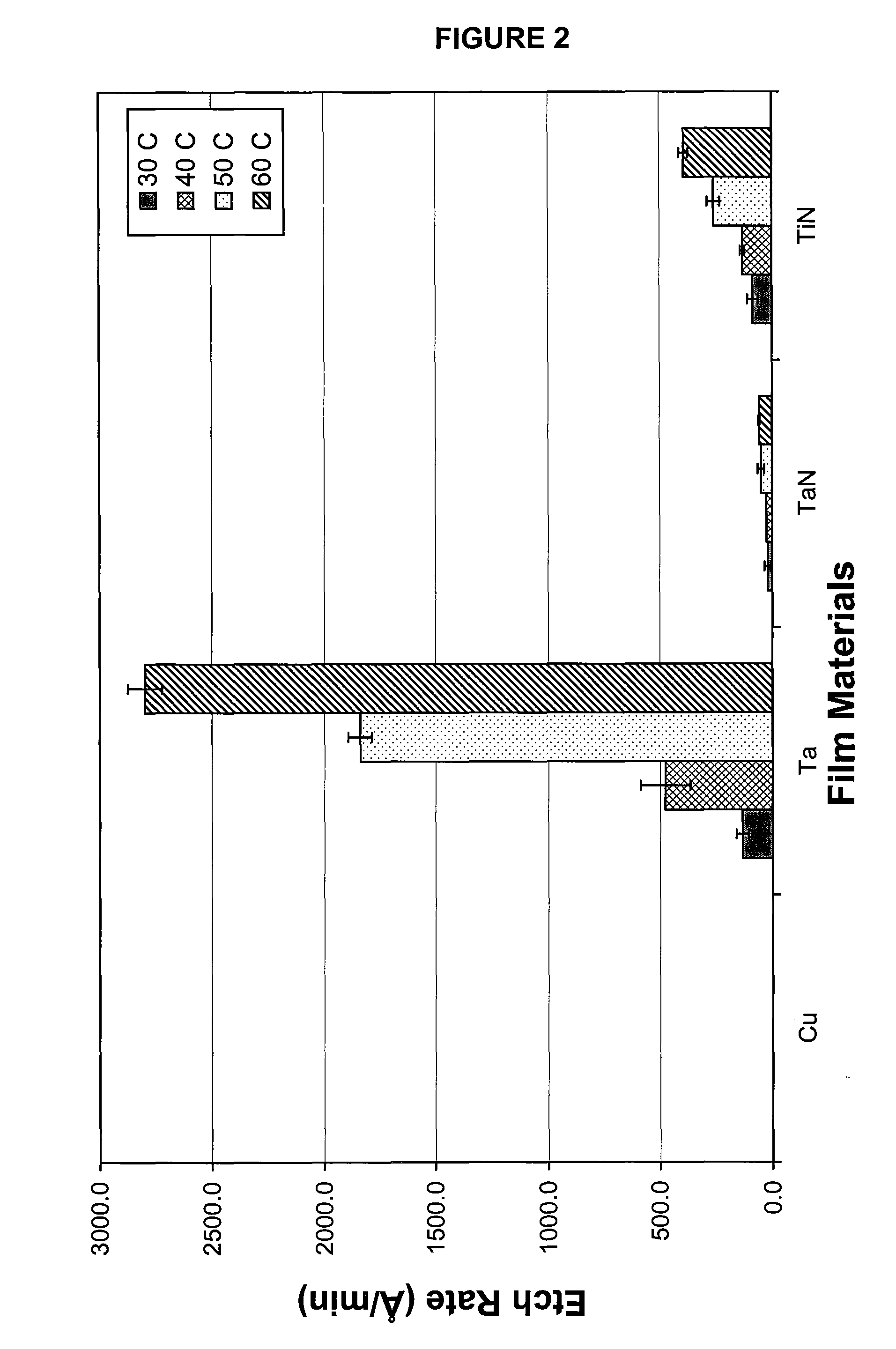Composition and Method for Recycling Semiconductor Wafers Having Low-K Dielectric Materials Thereon
a technology of dielectric materials and semiconductor wafers, applied in the field of composition and method for recycling semiconductor wafers having low-k dielectric materials thereon, can solve the problems of non-uniform deposition of cdo layer, processing problems, and significant non-productive cos
- Summary
- Abstract
- Description
- Claims
- Application Information
AI Technical Summary
Benefits of technology
Problems solved by technology
Method used
Image
Examples
example 1
[0129]The pH of Formulation A diluted 20:1 with DI water was determined to be 3.2.
[0130]Bare Si substrates having blanketed BD materials thereon were statically soaked in concentrated Formulation A for 2 min to 5 min at 40° C. to 60° C. as indicated in Table 1. The BD material layers were characterized by the method of depositing the BLACK DIAMOND™ material as well as the thickness of the BD layers. The first bare Si substrate had a blanketed BLACK DIAMOND™ layer deposited using the proprietary BLACK DIAMOND™ process and had a thickness of approximately 6,500 Å (hereinafter BDTM). The second bare Si substrate had a blanketed BD derivative material deposited using a proprietary deposition process and had a thickness of approximately 13,000 Å (hereinafter BDD1). The third bare Si substrate had a blanketed BD derivative material deposited using another proprietary deposition process and had a thickness of approximately 12,000 Å (hereinafter BDD2).
[0131]The results of the static soak ar...
example 2
[0133]Blanketed polysilicon was statically soaked in Formulation A for 30 minutes at various temperatures and the etch rate of the polysilicon determined. The results are summarized in Table 2 hereinbelow.
TABLE 2Results of static soak of polysilicon in Formulation A.PolySi etchtemperature / ° C.rate / Å min−1401.1501.4601.7
[0134]It can be seen that the etch rate of polysilicon in Formulation A was negligible in the temperature range studied herein at extreme soaking conditions, e.g., a soak for 30 minutes. This suggests that Formulation A will not damage the underlying polysilicon material.
example 3
[0135]Samples of bare silicon, BDTM, BDD1, and BDD2 were statically soaked in Formulation A for 200 minutes at 60° C. to mimic extreme soaking conditions. Following immersion for the specified time, the samples were removed from the static soak bath, rinsed, dried and the Atomic Force Microscopic (AFM) surface roughness determined. The results are reported in Table 3 hereinbelow.
TABLE 3Results of static soak of bare Si and BD materials in Formulation A.Formulation Acontrolbare SiBDTMbare Si (nm)(nm)(nm)BDD1 (nm)BDD2 (nm)1 m scan0.1740.4020.3360.4050.3805 m scan0.1450.6880.2960.5710.503
[0136]It can be seen that the bare Si substrate was not significantly damaged during the extreme soak of the respective substrates in Formulation A. For example, the largest numerical change from 0.145 nm to 0.688 nm equates to negligible damage to the surface of the bare Si surface. These results suggest that Formulation A will not damage the underlying bare Si substrate either.
PUM
| Property | Measurement | Unit |
|---|---|---|
| dielectric constant | aaaaa | aaaaa |
| COD | aaaaa | aaaaa |
| COD | aaaaa | aaaaa |
Abstract
Description
Claims
Application Information
 Login to View More
Login to View More - R&D
- Intellectual Property
- Life Sciences
- Materials
- Tech Scout
- Unparalleled Data Quality
- Higher Quality Content
- 60% Fewer Hallucinations
Browse by: Latest US Patents, China's latest patents, Technical Efficacy Thesaurus, Application Domain, Technology Topic, Popular Technical Reports.
© 2025 PatSnap. All rights reserved.Legal|Privacy policy|Modern Slavery Act Transparency Statement|Sitemap|About US| Contact US: help@patsnap.com



